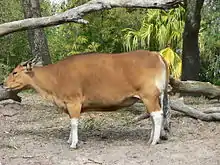List of mammals of Cambodia
This is a list of the mammal species recorded in Cambodia.[1]
The following tags are used to highlight each species' conservation status as assessed by the International Union for Conservation of Nature:
| EX | Extinct | No reasonable doubt that the last individual has died. |
| EW | Extinct in the wild | Known only to survive in captivity or as a naturalized populations well outside its previous range. |
| CR | Critically endangered | The species is in imminent risk of extinction in the wild. |
| EN | Endangered | The species is facing an extremely high risk of extinction in the wild. |
| VU | Vulnerable | The species is facing a high risk of extinction in the wild. |
| NT | Near threatened | The species does not meet any of the criteria that would categorise it as risking extinction but it is likely to do so in the future. |
| LC | Least concern | There are no current identifiable risks to the species. |
| DD | Data deficient | There is inadequate information to make an assessment of the risks to this species. |
Order: Proboscidea (elephants)

The elephants comprise three living species and are the largest living land animals.
- Family: Elephantidae (elephants)
- Genus: Elephas
- Asian elephant, E. maximus EN[2]
- Genus: Elephas
Order: Sirenia (manatees and dugongs)

Sirenia is an order of fully aquatic, herbivorous mammals that inhabit rivers, estuaries, coastal marine waters, swamps, and marine wetlands. All four species are endangered.
- Family: Dugongidae
Order: Scandentia (treeshrews)
The treeshrews are small mammals native to the tropical forests of Southeast Asia. Although called treeshrews, they are not true shrews and are not all arboreal.
- Family: Tupaiidae (tree shrews)
- Genus: Dendrogale
- Northern smooth-tailed treeshrew, D. murina LC
- Genus: Tupaia
- Northern treeshrew, T. belangeri LC[4]
- Genus: Dendrogale
Order: Dermoptera (colugos)
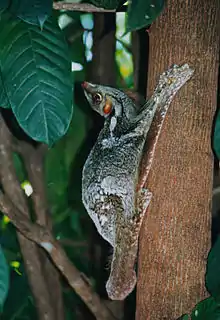
The two species of colugos make up the order Dermoptera. They are arboreal gliding mammals found in Southeast Asia.
- Family: Cynocephalidae (flying lemurs)
- Genus: Galeopterus
- Sunda flying lemur, G. variegatus LC[5]
- Genus: Galeopterus
Order: Primates
The order Primates contains humans and their closest relatives: lemurs, lorisoids, monkeys, and apes.
- Suborder: Strepsirrhini
- Infraorder: Lemuriformes
- Superfamily: Lorisoidea
- Family: Lorisidae (lorises, bushbabies)
- Genus: Nycticebus
- Bengal slow loris, N. bengalensis EN[6]
- Sunda slow loris, N. coucang EN[7]
- Pygmy slow loris, N. pygmaeus EN[8]
- Genus: Nycticebus
- Family: Lorisidae (lorises, bushbabies)
- Superfamily: Lorisoidea
- Infraorder: Lemuriformes
- Suborder: Haplorhini
- Infraorder: Simiiformes
- Parvorder: Catarrhini
- Superfamily: Cercopithecoidea
- Family: Cercopithecidae (Old World monkeys)
- Genus: Macaca
- Stump-tailed macaque, M. arctoides VU[9]
- Crab-eating macaque, M. fascicularis VU[10]
- Northern pig-tailed macaque, M. leonina VU
- Subfamily: Colobinae
- Genus: Trachypithecus
- Germain's langur, T. germaini EN
- Annamese langur, T. margarita
- Genus: Pygathrix
- Red-shanked douc, P. nemaeus EN
- Black-shanked douc, P. nigripes EN
- Genus: Trachypithecus
- Genus: Macaca
- Family: Cercopithecidae (Old World monkeys)
- Superfamily: Hominoidea
- Family: Hylobatidae (gibbons)
- Genus: Hylobates
- Pileated gibbon, H. pileatus VU
- Genus: Nomascus
- Yellow-cheeked crested gibbon, N. gabriellae VU
- Genus: Hylobates
- Family: Hylobatidae (gibbons)
- Superfamily: Cercopithecoidea
- Parvorder: Catarrhini
- Infraorder: Simiiformes
Order: Rodentia (rodents)
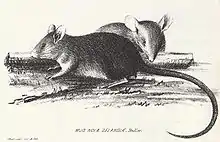

Rodents make up the largest order of mammals, with over 40% of mammalian species. They have two incisors in the upper and lower jaw which grow continually and must be kept short by gnawing. Most rodents are small though the capybara can weigh up to 45 kg (100 lb).
- Suborder: Hystricognathi
- Family: Hystricidae (Old World porcupines)
- Genus: Hystrix
- Malayan porcupine, H. brachyura LC[11]
- Genus: Hystrix
- Family: Hystricidae (Old World porcupines)
- Suborder: Sciurognathi
- Family: Sciuridae (squirrels)
- Subfamily: Ratufinae
- Genus: Ratufa
- Black giant squirrel, R. bicolor NT
- Genus: Ratufa
- Subfamily: Sciurinae
- Tribe: Pteromyini
- Genus: Hylopetes
- Particolored flying squirrel, Hylopetes alboniger EN
- Genus: Hylopetes
- Tribe: Pteromyini
- Subfamily: Callosciurinae
- Genus: Callosciurus
- Finlayson's squirrel, Callosciurus finlaysonii
- Genus: Dremomys
- Asian red-cheeked squirrel, Dremomys rufigenis
- Genus: Menetes
- Berdmore's ground squirrel, Menetes berdmorei
- Genus: Tamiops
- Himalayan striped squirrel, Tamiops macclellandi
- Cambodian striped squirrel, Tamiops rodolphei
- Genus: Callosciurus
- Subfamily: Ratufinae
- Family: Spalacidae
- Subfamily: Rhizomyinae
- Genus: Cannomys
- Lesser bamboo rat, Cannomys badius
- Genus: Rhizomys
- Hoary bamboo rat, Rhizomys pruinosus
- Large bamboo rat, Rhizomys sumatrensis
- Genus: Cannomys
- Subfamily: Rhizomyinae
- Family: Muridae (mice, rats, voles, gerbils, hamsters, etc.)
- Subfamily: Murinae
- Genus: Berylmys
- Small white-toothed rat, Berylmys berdmorei
- Genus: Leopoldamys
- Long-tailed giant rat, Leopoldamys sabanus
- Genus: Maxomys
- Red spiny rat, Maxomys surifer
- Genus: Mus
- Ryukyu mouse, Mus caroli
- Fawn-colored mouse, Mus cervicolor
- Shortridge's mouse, Mus shortridgei
- Genus: Niviventer
- Chestnut white-bellied rat, Niviventer fulvesces
- Genus: Rattus
- Ricefield rat, Rattus argentiventer
- Polynesian rat, Rattus exulans
- Brown rat, R. norvegicus LC introduced[12]
- Sikkim rat, Rattus sikkimensis VU
- Tanezumi rat, Rattus tanezumi
- Genus: Vandeleuria
- Asiatic long-tailed climbing mouse, Vandeleuria oleracea
- Genus: Berylmys
- Subfamily: Murinae
- Family: Sciuridae (squirrels)
Order: Lagomorpha (lagomorphs)
The lagomorphs comprise two families, Leporidae (hares and rabbits), and Ochotonidae (pikas). Though they can resemble rodents, and were classified as a superfamily in that order until the early 20th century, they have since been considered a separate order. They differ from rodents in a number of physical characteristics, such as having four incisors in the upper jaw rather than two.
- Family: Leporidae (rabbits, hares)
- Genus: Lepus
- Burmese hare, L. peguensis LC
- Genus: Lepus
Order: Erinaceomorpha (hedgehogs and gymnures)
The order Erinaceomorpha contains a single family, Erinaceidae, which comprise the hedgehogs and gymnures. The hedgehogs are easily recognised by their spines while gymnures look more like large rats.
- Family: Erinaceidae (hedgehogs)
- Subfamily: Galericinae
- Genus: Hylomys
- Short-tailed gymnure, H. suillus LC
- Genus: Hylomys
- Subfamily: Galericinae
Order: Soricomorpha (shrews, moles, and solenodons)
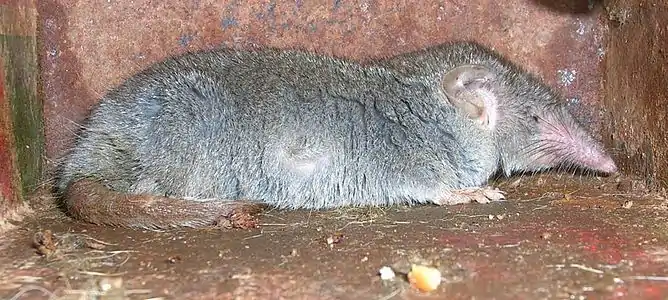
The "shrew-forms" are insectivorous mammals. The shrews and solenodons closely resemble mice while the moles are stout-bodied burrowers.
- Family: Soricidae (shrews)
- Subfamily: Crocidurinae
- Genus: Crocidura
- Southeast Asian shrew, Crocidura fuliginosa
- Indochinese shrew, Crocidura indochinensis
- Dr. Phan Luong shrew, Crocidura phanluongi
- Genus: Suncus
- Asian house shrew, S. murinus LC[13]
- Genus: Crocidura
- Subfamily: Crocidurinae
Order: Chiroptera (bats)
The bats' most distinguishing feature is that their forelimbs are developed as wings, making them the only mammals capable of flight. Bat species account for about 20% of all mammals.
- Family: Pteropodidae (flying foxes, Old World fruit bats)
- Subfamily: Pteropodinae
- Genus: Cynopterus
- Lesser short-nosed fruit bat, C. brachyotis LC[14]
- Greater short-nosed fruit bat, Cynopterus sphinx
- Genus: Pteropus
- Small flying fox, Pteropus hypomelanus
- Lyle's flying fox, Pteropus lylei
- Large flying fox, Pteropus vampyrus
- Genus: Rousettus
- Geoffroy's rousette, Rousettus amplexicaudatus
- Leschenault's rousette, Rousettus leschenaulti
- Genus: Cynopterus
- Subfamily: Pteropodinae
- Family: Vespertilionidae
- Subfamily: Myotinae
- Genus: Myotis
- Lesser large-footed bat, Myotis hasseltii
- Whiskered myotis, Myotis muricola
- Thick-thumbed myotis, Myotis rosseti
- Himalayan whiskered bat, Myotis siligorensis
- Genus: Myotis
- Subfamily: Vespertilioninae
- Genus: Hesperoptenus
- Blanford's bat, Hesperoptenus blanfordi
- Tickell's bat, Hesperoptenus tickelli
- Genus: Pipistrellus
- Indian pipistrelle, Pipistrellus coromandra
- Genus: Scotophilus
- Greater Asiatic yellow bat, Scotophilus heathi
- Genus: Tylonycteris
- Greater bamboo bat, Tylonycteris robustula
- Genus: Hesperoptenus
- Subfamily: Myotinae
- Family: Molossidae
- Genus: Chaerephon
- Wrinkle-lipped free-tailed bat, Chaerephon plicata
- Genus: Chaerephon
- Family: Emballonuridae
- Genus: Taphozous
- Long-winged tomb bat, Taphozous longimanus
- Black-bearded tomb bat, Taphozous melanopogon
- Genus: Taphozous
- Family: Megadermatidae
- Genus: Megaderma
- Lesser false vampire bat, Megaderma spasma
- Genus: Megaderma
- Family: Rhinolophidae
- Subfamily: Rhinolophinae
- Genus: Rhinolophus
- Acuminate horseshoe bat, Rhinolophus acuminatus
- Bornean horseshoe bat, Rhinolophus borneensis
- Woolly horseshoe bat, Rhinolophus luctus
- Malayan horseshoe bat, Rhinolophus malayanus
- Shamel's horseshoe bat, Rhinolophus shameli
- Genus: Rhinolophus
- Subfamily: Hipposiderinae
- Genus: Hipposideros
- Fulvus roundleaf bat, Hipposideros fulvus
- Intermediate roundleaf bat, Hipposideros larvatus
- Genus: Hipposideros
- Subfamily: Rhinolophinae
Order: Pholidota (pangolins)
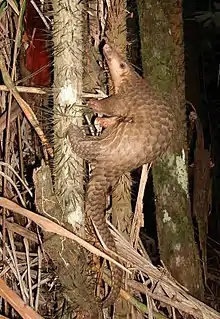
The order Pholidota comprises the eight species of pangolin. Pangolins are anteaters and have the powerful claws, elongated snout and long tongue seen in the other unrelated anteater species.
- Family: Manidae
- Genus: Manis
- Sunda pangolin, M. javanica CR[15]
- Chinese pangolin, M. pentadactyla CR[16]
- Genus: Manis
Order: Cetacea (whales)
The order Cetacea includes whales, dolphins and porpoises. They are the mammals most fully adapted to aquatic life with a spindle-shaped nearly hairless body, protected by a thick layer of blubber, and forelimbs and tail modified to provide propulsion underwater.
- Suborder: Mysticeti
- Family: Balaenopteridae
- Genus: Balaenoptera
- Common minke whale, B. acutorostrata LC[17]
- Sei whale, Balaenoptera borealis EN
- Bryde's whale, Balaenoptera brydei DD
- Blue whale, Balaenoptera musculus EN
- Fin whale, Balaenoptera physalus EN
- Genus: Megaptera
- Humpback whale, Megaptera novaeangliae LC
- Genus: Balaenoptera
- Family: Balaenopteridae
- Suborder: Odontoceti
- Superfamily: Platanistoidea
- Family: Phocoenidae
- Genus: Neophocaena
- Finless porpoise, Neophocaena phocaenoides DD
- Genus: Neophocaena
- Family: Delphinidae (marine dolphins)
- Genus: Delphinus
- Long-beaked common dolphin, Delphinus capensis DD
- Genus: Globicephala
- Short-finned pilot whale, Globicephala macrorhynchus DD
- Genus: Sousa
- Chinese white dolphin, Sousa chinensis DD
- Genus: Tursiops
- Common bottlenose dolphin, Tursiops truncatus DD
- Indo-Pacific bottlenose dolphin, Tursiops aduncus DD
- Genus: Stenella
- Pantropical spotted dolphin, Stenella attenuata
- Striped dolphin, Stenella coeruleoalba
- Spinner dolphin, Stenella longirostris
- Genus: Steno
- Rough-toothed dolphin, Steno bredanensis DD
- Genus: Lagenodelphis
- Fraser's dolphin, Lagenodelphis hosei DD
- Genus: Grampus
- Risso's dolphin, Grampus griseus DD
- Genus: Feresa
- Pygmy killer whale, Feresa attenuata DD
- Genus: Pseudorca
- False killer whale, Pseudorca crassidens DD
- Genus: Orcinus
- Genus: Peponocephala
- Melon-headed whale, Peponocephala electra DD
- Genus: Orcaella
- Irrawaddy dolphin, Orcaella brevirostris DD
- Genus: Delphinus
- Family: Physeteridae
- Genus: Physeter
- Sperm whale, Physeter macrocephalus VU
- Genus: Physeter
- Family: Kogiidae
- Genus: Kogia
- Pygmy sperm whale, K. breviceps DD[19]
- Dwarf sperm whale, Kogia sima DD
- Genus: Kogia
- Family: Phocoenidae
- Superfamily: Ziphioidea (beaked whales)
- Family: Ziphidae
- Genus: Mesoplodon
- Blainville's beaked whale, Mesoplodon densirostris DD
- Ginkgo-toothed beaked whale, Mesoplodon ginkgodens DD
- Genus: Ziphius
- Cuvier's beaked whale, Ziphius cavirostris DD
- Genus: Mesoplodon
- Family: Ziphidae
- Superfamily: Platanistoidea
Order: Carnivora (carnivorans)
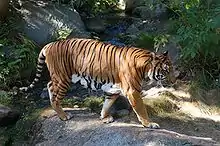
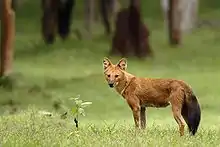
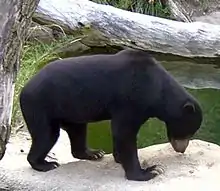
There are over 260 species of carnivorans, the majority of which feed primarily on meat. They have a characteristic skull shape and dentition.
- Suborder: Feliformia
- Family: Felidae (cats)
- Subfamily: Felinae
- Genus: Catopuma
- Genus: Felis
- Jungle cat, F. chaus LC[21]
- Genus: Pardofelis
- Marbled cat, P. marmorata NT[22]
- Genus: Prionailurus
- Leopard cat, P. bengalensis LC[23]
- Fishing cat, P. viverrinus VU[24]
- Subfamily: Pantherinae
- Genus: Neofelis
- Clouded leopard, N. nebulosa VU[25]
- Genus: Panthera
- Leopard, P. pardus VU[26]
- Indochinese leopard, P. p. delacouri
- Tiger, P. tigris EN[27]
- Leopard, P. pardus VU[26]
- Genus: Neofelis
- Subfamily: Felinae
- Family: Viverridae (civets, mongooses, etc.)
- Subfamily: Paradoxurinae
- Genus: Arctictis
- Genus: Paguma
- Masked palm civet, P. larvata LC[29]
- Genus: Paradoxurus
- Asian palm civet, P. hermaphroditus LC[30]
- Subfamily: Viverrinae
- Genus: Viverra
- Large-spotted civet, V. megaspila LC[31]
- Malayan civet, Viverra tangalunga LC[32]
- Large Indian civet, V. zibetha LC[33]
- Genus: Viverricula
- Small Indian civet, V. indica LC[34]
- Genus: Viverra
- Subfamily: Paradoxurinae
- Family: Herpestidae (mongooses)
- Genus: Herpestes
- Javan mongoose, H. javanicus LC[35]
- Genus: Herpestes
- Family: Felidae (cats)
- Suborder: Caniformia
- Family: Canidae (dogs, foxes)
- Family: Ursidae (bears)
- Family: Mustelidae (mustelids)
- Genus: Aonyx
- Asian small-clawed otter, A. cinereus VU[39]
- Genus: Arctonyx
- Hog badger, A. collaris VU[40]
- Genus: Lutra
- Eurasian otter, L. lutra NT[41]
- Hairy-nosed otter, L. sumatrana EN[42]
- Genus: Lutrogale
- Smooth-coated otter, L. perspicillata VU[43]
- Genus: Martes
- Yellow-throated marten, M. flavigula LC[44]
- Genus: Melogale
- Burmese ferret badger, M. personata LC[45]
- Genus: Mustela
- Yellow-bellied weasel, M. kathiah LC[46]
- Genus: Aonyx
Order: Perissodactyla (odd-toed ungulates)
The odd-toed ungulates are browsing and grazing mammals. They are usually large to very large, and have relatively simple stomachs and a large middle toe.
- Family: Rhinocerotidae
- Genus: Dicerorhinus
- Sumatran rhinoceros, D. sumatrensis extirpated
- Northern Sumatran rhinoceros, D. s. lasiotis CR, possibly EX
- Sumatran rhinoceros, D. sumatrensis extirpated
- Genus: Rhinoceros
- Javan rhinoceros, R. sondaicus extirpated
- Vietnamese Sunda rhinoceros, R. s. annamaticus CR, possibly EX
- Javan rhinoceros, R. sondaicus extirpated
- Genus: Dicerorhinus
Order: Artiodactyla (even-toed ungulates)
The even-toed ungulates are ungulates whose weight is borne about equally by the third and fourth toes, rather than mostly or entirely by the third as in perissodactyls. There are about 220 artiodactyl species, including many that are of great economic importance to humans.
- Family: Suidae (pigs)
- Family: Tragulidae
- Genus: Tragulus
- Lesser mouse deer, Tragulus kandil LC
- Greater mouse deer, Tragulus napu LC
- Genus: Tragulus
- Family: Cervidae (deer)
- Subfamily: Cervinae
- Genus: Panolia
- Eld's deer, P. eldii EN[48]
- Genus: Rusa
- Sambar deer, R. unicolor VU[49]
- Genus: Panolia
- Subfamily: Muntiacinae
- Genus: Muntiacus
- Indian muntjac, M. muntjak LC[50]
- Giant muntjac, M. vuquangensis EN
- Genus: Muntiacus
- Subfamily: Cervinae
- Family: Bovidae (cattle, antelope, sheep, goats)
- Subfamily: Bovinae
- Genus: Bubalus
- Wild water buffalo, B. arnee EN[53]
- Subfamily: Caprinae
- Genus: Capricornis
- Mainland serow, C. sumatraensis VU[54]
- Genus: Capricornis
See also
References
- This list is derived from the IUCN Red List which lists species of mammals and includes those mammals that have recently been classified as extinct (since 1500 AD). The taxonomy and naming of the individual species is based on those used in existing Wikipedia articles as of 21 May 2007 and supplemented by the common names and taxonomy from the IUCN, Smithsonian Institution, or University of Michigan where no Wikipedia article was available.
- Choudhury, A.; Lahiri Choudhury, D. K.; Desai, A.; Duckworth, J. W.; Easa, P. S.; Johnsingh, A. J. T.; Fernando, P.; Hedges, S.; Gunawardena, M.; Kurt, F.; Karanth, U; Lister, A.; Menon, V.; Riddle, H.; Rübel, A. & Wikramanayake, E. (2008). "Elephas maximus". IUCN Red List of Threatened Species. 2008: e.T7140A12828813.
- Marsh, H. & Sobtzick, S. (2019). "Dugong dugon". IUCN Red List of Threatened Species. 2019: e.T6909A160756767.
- Han, K. H.; Duckworth, J. W. & Molur, S. (2016). "Tupaia belangeri". IUCN Red List of Threatened Species. 2016: e.T41492A22280884.
- Boeadi & Steinmetz, R. (2008). "Galeopterus variegatus". IUCN Red List of Threatened Species. 2008: e.T41502A10479343.
- Nekaris, K.A.I.; Al-Razi, H.; Blair, M.; Das, J.; Ni, Q.; Samun, E.; Streicher, U.; Xue-long, J. & Yongcheng, L. (2020). "Nycticebus bengalensis". IUCN Red List of Threatened Species. 2020: e.T39758A17970536.
- Nekaris, K.A.I.; Poindexter, S. & Streicher, U. (2020). "Nycticebus coucang". IUCN Red List of Threatened Species. 2020: e.T163017685A17970966.
- Blair, M.; Nadler, T.; Ni, O.; Samun, E.; Streicher, U. & Nekaris, K.A.I. (2020). "Nycticebus pygmaeus". IUCN Red List of Threatened Species. 2020: e.T14941A17971417.
- Chetry, D.; Long, Y.; Htun, S.; Timmins, R.J.; Boonratana, R. & Das, J. (2020). "Macaca arctoides". IUCN Red List of Threatened Species. 2020: e.T12548A17949098.
- Eudey, A.; Kumar, A.; Singh, M. & Boonratana, R. (2020). "Macaca fascicularis". IUCN Red List of Threatened Species. 2020: e.T12551A17949449.
- Lunde, D.; Aplin, K. & Molur, S. (2016). "Hystrix brachyura". IUCN Red List of Threatened Species. 2016: e.T10749A11509929.
- Ruedas, L. (2016). "Rattus norvegicus". IUCN Red List of Threatened Species. 2016: e.T19353A165118026.
- Hutterer, R.; Molur, S. & Heaney, L. (2016). "Suncus murinus". IUCN Red List of Threatened Species. 2016: e.T41440A22287830.
- Csorba, G.; Bumrungsri, S.; Bates, P.; Gumal, M.; Kingston, T.; Molur, S.; Srinivasulu, C. (2019). "Cynopterus brachyotis". IUCN Red List of Threatened Species. 2019: e.T6103A22113381.
- Challender, D.; Willcox, D.H.A.; Panjang, E.; Lim, N.; Nash, H.; Heinrich, S. & Chong, J. (2019). "Manis javanica". IUCN Red List of Threatened Species. 2019: e.T12763A123584856.
- Challender, D.; Wu, S.; Kaspal, P.; Khatiwada, A.; Ghose, A.; Ching-Min Su, N. & Laxmi Suwal, T. (2019). "Manis pentadactyla". IUCN Red List of Threatened Species. 2019: e.T12764A123585318.
- Cooke, J.G. (2018). "Balaenoptera acutorostrata". IUCN Red List of Threatened Species. 2018: e.T2474A50348265.
- Reeves, R.; Pitman, R.L. & Ford, J.K.B. (2017). "Orcinus orca". IUCN Red List of Threatened Species. 2017: e.T15421A50368125.
- Taylor, B.L.; Baird, R.; Barlow, J.; Dawson, S.M. & Ford, J.K.B.; Mead, J.G.; Notarbartolo di Sciara, G.; Wade, P. & Pitman, R.L. (2012). "Kogia breviceps". IUCN Red List of Threatened Species. 2012: e.T11047A17692192.CS1 maint: multiple names: authors list (link)
- McCarthy, J.; Dahal, S.; Dhendup, T.; Gray, T.N.E.; Mukherjee, S.; Rahman, H.; Riordan, P.; Boontua, N. & Wilcox, D. (2015). "Catopuma temminckii". IUCN Red List of Threatened Species. 2015: e.T4038A97165437.
- Gray, T.N.E.; Timmins, R.J.; Jathana, D.; Duckworth, J.W.; Baral, H. & Mukherjee, S. (2016). "Felis chaus". IUCN Red List of Threatened Species. 2016: e.T8540A50651463.
- Ross, J.; Brodie, J.; Cheyne, S.; Datta, A.; Hearn, A.; Loken, B.; Lynam, A.; McCarthy, J.; Phan, C.; Rasphone, A.; Singh, P.; Wilting, A. (2016). "Pardofelis marmorata". IUCN Red List of Threatened Species. 2016: e.T16218A97164299.
- Ross, J.; Brodie, J.; Cheyne, S.; Hearn, A.; Izawa, M.; Loken, B.; Lynam, A.; McCarthy, J.; Mukherjee, S.; Phan, C.; Rasphone, A. & Wilting, A. (2015). "Prionailurus bengalensis". IUCN Red List of Threatened Species. 2015: e.T18146A50661611.
- Mukherjee, S.; Appel, A.; Duckworth, J. W.; Sanderson, J.; Dahal, S.; Willcox, D. H. A.; Herranz Muñoz, V.; Malla, G.; Ratnayaka, A.; Kantimahanti, M.; Thudugala, A.; Thaung, R.; Rahman, H. (2016). "Prionailurus viverrinus". IUCN Red List of Threatened Species. 2016: e.T18150A50662615.
- Grassman, L.; Lynam, A.; Mohamad, S.; Duckworth, J. W.; Borah, J.; Willcox, D.; Ghimirey, Y.; Reza, A. & Rahman, H. (2016). "Neofelis nebulosa". IUCN Red List of Threatened Species. 2016: e.T14519A97215090.
- Stein, A.B.; Athreya, V.; Gerngross, P.; Balme, G.; Henschel, P.; Karanth, U.; Miquelle, D.; Rostro-Garcia, S.; Kamler, J. F.; Laguardia, A.; Khorozyan, I. & Ghoddousi, A. (2019). "Panthera pardus". IUCN Red List of Threatened Species. 2019: e.T15954A160698029.
- Goodrich, J.; Lynam, A.; Miquelle, D.; Wibisono, H.; Kawanishi, K.; Pattanavibool, A.; Htun, S.; Tempa, T.; Karki, J.; Jhala, Y. & Karanth, U. (2015). "Panthera tigris". IUCN Red List of Threatened Species. 2015: e.T15955A50659951.
- Willcox, D.H.A.; Chutipong, W.; Gray, T.N.E.; Cheyne, S.; Semiadi, G.; Rahman, H.; Coudrat, C.N.Z.; Jennings, A.; Ghimirey, Y.; Ross, J.; Fredriksson, G.; Tilker, A. (2016). "Arctictis binturong". IUCN Red List of Threatened Species. 2016: e.T41690A45217088.
- Duckworth, J.W.; Timmins, R.J.; Chutipong, W.; Choudhury, A.; Mathai, J.; Willcox, D.H.A.; Ghimirey, Y.; Chan, B. & Ross, J. (2016). "Paguma larvata". IUCN Red List of Threatened Species. 2016: e.T41692A45217601.
- Duckworth, J.W.; Timmins, R.J.; Choudhury, A.; Chutipong, W.; Willcox, D.H.A.; Mudappa, D.; Rahman, H.; Widmann, P.; Wilting, A. & Xu, W. (2016). "Paradoxurus hermaphroditus". IUCN Red List of Threatened Species. 2016: e.T41693A45217835.
- Timmins, R.; Duckworth, J.W.; WWF-Malaysia; Roberton, S.; Gray, T.N.E.; Willcox, D.H.A.; Chutipong, W. & Long, B. (2016). "Viverra megaspila". IUCN Red List of Threatened Species. 2016: e.T41707A45220097.
- Duckworth, J.W.; Mathai, J.; Wilting, A.; Holden, J.; Hearn, A. & Ross, J. (2016). "Viverra tangalunga". IUCN Red List of Threatened Species. 2016: e.T41708A45220284.
- Timmins, R.J.; Duckworth, J.W.; Chutipong, W.; Ghimirey, Y.; Willcox, D.H.A.; Rahman, H.; Long, B. & Choudhury, A. (2016). "Viverra zibetha". IUCN Red List of Threatened Species. 2016: e.T41709A45220429.
- Choudhury, A.; Duckworth, J.W.; Timmins, R.; Chutipong, W.; Willcox, D.H.A.; Rahman, H.; Ghimirey, Y. & Mudappa, D. (2015). "Viverricula indica". IUCN Red List of Threatened Species. 2015: e.T41710A45220632.
- Chutipong, W.; Duckworth, J. W.; Timmins, R.; Willcox, D. H. A. & Ario, A. (2016). "Herpestes javanicus". IUCN Red List of Threatened Species. 2016: e.T70203940A45207619.
- Kamler, J. F.; Songsasen, N.; Jenks, K.; Srivathsa, A.; Sheng, L. & Kunkel, K. (2015). "Cuon alpinus". IUCN Red List of Threatened Species. 2015: e.T5953A72477893.
- Scotson, L.; Fredriksson, G.; Augeri, D.; Cheah, C.; Ngoprasert, D. & Wai-Ming, W. (2017). "Helarctos malayanus (errata version published in 2018)". IUCN Red List of Threatened Species. 2017: e.T9760A123798233.
- Garshelis, D. L. & Steinmetz, R. (2016). "Ursus thibetanus". IUCN Red List of Threatened Species. 2016: e.T22824A114252336.
- Wright, L.; de Silva, P.; Chan, B. & Reza Lubis, I. (2015). "Aonyx cinereus". IUCN Red List of Threatened Species. 2015: e.T44166A21939068. Retrieved 29 October 2018.
- Duckworth, J.W.; Timmins, R.J.; Chutipong, W.; Gray, T.N.E.; Long, B.; Helgen, K.; Rahman, H.; Choudhury, A. & Willcox, D.H.A. (2016). "Arctonyx collaris". IUCN Red List of Threatened Species. 2016: e.T70205537A45209459.CS1 maint: multiple names: authors list (link)
- Roos, A.; Loy, A.; de Silva, P.; Hajkova, P. & Zemanová, B. (2015). "Lutra lutra". IUCN Red List of Threatened Species. 2015: e.T12419A21935287.
- Aadrean, A.; Kanchanasaka, B.; Heng, S.; Reza Lubis, I.; de Silva, P. & Olsson, A. (2015). "Lutra sumatrana". IUCN Red List of Threatened Species. 2015: e.T12421A21936999.
- de Silva, P.; Khan, W.A.; Kanchanasaka, B.; Reza Lubis, I.; Feeroz, M. M. & Al-Sheikhly, O.F. (2015). "Lutrogale perspicillata". IUCN Red List of Threatened Species. 2015: e.T12427A21934884.
- Chutipong, W.; Duckworth, J.W.; Timmins, R.J.; Choudhury, A.; Abramov, A.V.; Roberton, S.; Long, B.; Rahman, H.; Hearn, A.; Dinets, V. & Willcox, D.H.A. (2016). "Martes flavigula". IUCN Red List of Threatened Species. 2016: e.T41649A45212973.
- Duckworth, J.W.; Long, B.; Willcox, D.H.A.; Coudrat, C.N.Z.; Timmins, R.J.; Abramov, A.V.; Chan, B. & Chutipong, W. (2016). "Melogale personata". IUCN Red List of Threatened Species. 2016: e.T41627A45209826.
- Willcox, D.H.A.; Duckworth, J.W.; Timmins, R.J.; Abramov, A.V.; Choudhury, A.; Chutipong, W.; Chan, B.; Lau, M. & Roberton, S. (2016). "Mustela kathiah". IUCN Red List of Threatened Species. 2016: e.T41655A45214014.
- {{Cite iucn |title=Sus scrofa |name-list-style=amp |author=Keuling, O. |author2=Leus, K. |page=e.T41775A44141833 |date=2019}
- Gray, T.N.E.; Brook, S.M.; McShea, W.J.; Mahood, S.; Ranjitsingh, M.K.; Miyunt, A.; Hussain, S.A. & Timmins, R.J. (2015). "Rucervus eldii". IUCN Red List of Threatened Species. 2015: e.T4265A22166803.
- Timmins, R.J.; Kawanishi, K.; Giman, B.; Lynam, A.J.; Chan, B.; Steinmetz, R.; Baral, H. S. & Samba Kumar, N. (2015). "Rusa unicolor". IUCN Red List of Threatened Species. 2015: e.T41790A85628124.
- Timmins, R. J.; Duckworth, J. W. & Hedges, S. (2016). "Muntiacus muntjak". IUCN Red List of Threatened Species. 2016: e.T42190A56005589.
- Duckworth, J. W.; Sankar, K.; Williams, A. C.; Samba Kumar, N. & Timmins, R. J. (2016). "Bos gaurus". IUCN Red List of Threatened Species. 2016: e.T2891A46363646.
- Gardner, P.; Hedges, S.; Pudyatmoko, S.; Gray, T.N.E. & Timmins, R.J. (2016). "Bos javanicus". IUCN Red List of Threatened Species. 2016: e.T2888A46362970.
- Kaul, R.; Williams, A.C.; Steinmetz, R. & Mishra, R. (2019). "Bubalus arnee". IUCN Red List of Threatened Species. 2019: e.T3129A46364616.
- Phan, T.D.; Nijhawan, S.; Li, S. & Xiao, L. (2020). "Capricornis sumatraensis". IUCN Red List of Threatened Species. 2020: e.T162916735A162916910.
External links
- "Animal Diversity Web". University of Michigan Museum of Zoology. 1995–2006. Retrieved 22 May 2007.

